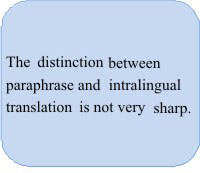Paraphrase
If intralingual translation is from one form of the same language
to the other, then wha t is the difference between this and paraphrase? Ordinarily we term it as paraphrase when we narrate somebody else’s text in our own words – or we ‘translate’ it into our words. Douglas Robinson observes how the authors of The Living Bible state that theirs is a paraphrase rather than a translation. This is because their version of the Bible published in 1971, is a modern language version of another older English translation. t is the difference between this and paraphrase? Ordinarily we term it as paraphrase when we narrate somebody else’s text in our own words – or we ‘translate’ it into our words. Douglas Robinson observes how the authors of The Living Bible state that theirs is a paraphrase rather than a translation. This is because their version of the Bible published in 1971, is a modern language version of another older English translation.
Paraphrase as a term was originally coined by John Dryden by which he described one of the three translating techniques. The other two were metaphrase (word for word translation) and imitation (free translation that bears very little resemblance to the original). Dryden favoured the technique of paraphrase by which he meant a translation that allowed for the creativity of the translator without being too distant from the original. As Robinson points out, today this can also be termed a “variation” rather than a translation (“Paraphrase”, Routledge Encyclopedia of Translation Studies, 167).
A closely aligned form of paraphrase is what Robinson calls “pseudotranslation” (“Pseudotranslation”, Routledge Encyclopedia of Translation Studies, 183). He defines as pseudotranslation “a work, whose status as ‘original’ or ‘derivative’ is, for whatever textual or social reason, problematic” (183). Robinson argues that The Living Bible, despite its authors’ disclaimer that it is just a paraphrase, is still read as a translation. The readers feel that there is an original lurking behind this modern Bible and to Robinson, this amounts to a pseudotranslation.
Far-fetched as Robinson’s claim might be, it is true that many intralingual translations tread a thin line between translation, version / variation or pseudotranslation. For instance, how would you describe Shakespeare’s Julius Caesar? It is popularly known that Shakespeare wrote this play by borrowing facts from Plutarch’s Lives of the famous Romans and Greeks. But Shakespeare did not read Plutarch in the original. He relied on Thomas North’s English translation. North in turn had translated Plutarch from Amyot’s French translation. If this is the case, then what is Shakespeare’s play Julius Caesar? A play that is based on the translation of a translation of a historical work originally written in Latin – what does this imply? Does this mean that Julius Caesar is an intersemiotic translation from a historical text into a play? Since the English play is about a Roman leader, the reader might believe that it is an interlingual translation from a Roman historical work. If that is so, can the play be described as a pseudotranslation – even more so as it is based on a translation of another translation? Or is it an adaptation of a historical text? As you can see, the categories do not have clearly demarcated boundaries.
|